Our first Chinese Wedding
Sunday, September 26, 2010
 Shenzhen, Guangdong, China
Shenzhen, Guangdong, China
In 1979, Shenzhen was a small backwater fishing village . Six years later, it was transformed
into a shiny symbol of China's newfound experiment with capitalism. It was all done quietly by then Premier Peng who was determined to push China's hardliners into the modern era.
His experiment was a huge success. 20 years later, Shenzhen is a gleaming, modern city with clean highways, tall skyscrapers & a brand new subway similar to the one in Singapore - no food, no drinks, spic & span clean. You buy a token at a automated machine by touching the subway stop you want and sliding in your money. The token is simply placed on the turnstile for entry & deposited at the end of your trip to exit.
A monitor on the platform ticks off the minutes until the arrival of the next train. A glass partition separates the platform from the tracks for protection. The train's doors line up exactly with the doors in the partition. It's all very modern, safe and comfortably air conditioned . Inside, flashing electronic route maps show your location, how far you've travelled & the next stop, as an electronic voice announces the coming station in Chinese & English. And you can actually make out the words.
English signs are everywhere, unlike in Beijing two years ago. It may be the influence and big investments of neighbouring Hong Kong or just a draw for foreign investors.
The street signs are in Chinese and English too. That helps to a certain extent except that
the only maps available are all in Chinese, no pinion (which is the Chinese phonetic spelling that we use). So even if we know where we are, we can't find our location on the map or determine where we need to go next.
Shenzhen is now competing with Hong Kong for investment dollars and industry. It has three nuclear power plants to feed this industrial beast. It's even treated by some as a bedroom community for Hong Kong workers who make the one-hour commute daily . The cost of housing here is one-seventh of that in Hong Kong.
It turns out that Huanggang, where we got lost on our arrival, is just the main bus terminal for people crossing the border from Hong Kong. We didn't know that when we arrived and thought we were in a different town. Our friend Suling gave us the English name Huanggang Station, but nobody understood the Station part because it was English and this almost caused us a lot of grief.
We're staying in a huge modern suburb created by one company. It has a university, a shopping mall, apartment buildings, and three theme parks: Window on the World, Cartoon World and a
Multicultural Village with Chinese performances.
Our hotel is part of the Tourism College of Jinan University and we get to have our breakfast in the student cafeteria for 5 Yuan ($ .70). Its an odd process of buying a ticket, then lining up and pointing at things we think we might like, but we're not sure about . We're starting to recognize some items, but we know for sure that we don't like the "congee" , a soupy porridge-like hot broth with meat. Yecchh!
We've been invited to two family dinners now. The only problem is the use of chopsticks to serve food from the communal serving dishes in the middle of a round lazy susan. We were forewarned about this, but there's not much we can do about it. They insist on serving us with their sticks.
I've already caught Suling's mother's cold.
All around our hotel is a park with water features, manicured hedges, trees and modern sculpture. Wooden or stone walkways splashed by waterfalls cross ponds filled with koi. It's very calming. Behind our hotel is a large wooded hill with paths that wind up and down and around the hill.
Many of the trees are in bloom now in yellow, pinks & purples. I went for a walk this morning before it got too hot.
All along the trails, people are practicing Tai Chi or walking their dogs . Yes, they have them as pets too, not just to eat.
It's calm and quiet and the air is full of hovering dragonflies. A sweeper cleans the path with a
wooden broom that has two-foot long husks. Labour is cheap here and the streets and paths are kept clean by an army of sweepers.
In the distance you can see a pagoda atop the far-off mountains. A soft cooling breeze blows up the hill scenting the air with the sweet smells of fried breakfast dumplings.
Wedding day started with two of Xiaoyu's friends picking me up in a car at my hotel at 8:30 a.m. They drove me to Xiaoyu's hotel where 10 of his male friends had gathered for a traditional Chinese breakfast. None of the bride's family or male friends were included in this. A still photographer & a videographer were there to record the event.
We were all sitting around a large round table with a round Lazy Susan in the middle where heaping plates of food were placed . Everyone except Xiaoyu was smoking heavily, which made eating difficult for me.
Breakfast was a typical Chinese meal with Congee, sticky buns, different meats and vegetables. The food just kept coming out until the table was overflowing with food. There was much more than this group could eat and it was hard to believe there was a time when millions died in China because of the famine. I remember when I was a child being told by my parents to clean off my plate
because there were starving children in China.
At the end of breakfast, a couple of friends went off to decorate cars with roses. The cars, I should add, were provided by the company that organized the wedding photographers and pictures. There were four comfortable black sedans, a BMW, Audi, Nissan & a Camry, for the wedding party.
Several friends drove their own cars as well.
The same company that provided the cars had four dresses for the bride and a variety of suits for the groom for a two-day photo shoot a couple of weeks before the wedding . Several high-quality leather bound albums, several framed photos, 4x6s for the guests, fancy invitations, a video and a large 8-foot poster were all provided in a package that cost roughly $1,500, including the cars. The photos were shot in parks, on the beach or in a studio using backdrops that had them dressed in winter clothing on snowy fields, or in traditional Chinese wedding clothes in old fashioned scenes. Really amazing, professional stuff!
Around 9:30 a.m. all the men gathered at the entrance of the hotel where more pictures were taken. Someone pinned a corsage on me because I was part of the groom's "family" now.
After walkie talkies were handed out to the drivers, everyone jumped into the convoy of cars for a drive around the city with the groom. The videographer was in the lead car with his head and
camera stuck out of a sun roof to record the drive. I was designated "home movie man" and used Xiaoyu's handycam . I kept my head inside the weaving car.
We drove around for an hour. There was no honking of horns like we do in Canada after a wedding. Then we pulled up at the bride's parents' apartment block where Carol was waiting with the bride
and her friends and family in a traditional red Chinese wedding dress.
After spending several minutes at the main entrance gate answering questions designed to test the groom's worthiness, the men climbed the six flights of stairs to the apartment -- there is no elevator
in these buildings. The questions were just the first of three tests the groom had to pass.
At the door to the apartment, the groom had to answer more questions while the bride's friends yelled at us from inside. The men yelled back, pounded on the door and pushed red envelopes of money under the door to gain entrance. This went on for 10 minutes in the 90o heat and
humidity.
Once inside, we discovered that the women had all hidden inside the bride's bedroom . We were given water and a bowl of sweet noodles in a broth containing two boiled eggs. I was instructed to eat only one and leave the second. This is supposed to bring good luck. The noodles represent long life, the sweet broth, happiness, and the spherical egg, harmony and full life.
Another contest began at the bedroom door where the groom had to sing a song, swear undying love, and pass more red money packets under the door.
Then the door opened and the groom had to find the bride's two red shoes hidden somewhere in the room and answer more questions, sing a song, and recite poems in Chinese.
After this the bride and groom offered tea to the bride's parents in a formal ceremony that involved bowing and words of respect.
Then poor Xiaoyu had to carry the bride down the 6 flights of stairs in the heat. He almost dropped her at the end .
As, the bride and groom drove off to take another tour of the city with their friends, men exploded large 2-foot long firecracker tubes sending showers of coloured paper strips flying all over us.
The reception and exchange of vows were held in a hotel. The groom wore another black suit and the bride wore a traditional red costume to greet the 150 guests.
On each table were sunflower seeds, pistacchios and Moon cake to celebrate the mid-Autumn festival. Beside each table was a rack of pop, canned coconut milk, a bottle of red wine and a bottle of brandy. White wine is not served at weddings because white is the colour of mourning.
While we waited for dinner and the wedding couple, a video played on a large screen. This showed the bride and groom as children and during their university and work years. It had English subtitles for our benefit. Part of the video was a section that Carolann had recorded of Xiaoyu's Canadian work colleagues sending best wishes.
The video then switched to a pre-recorded shot of the bride and groom walking down the hallway to the reception area: the groom in a white tuxedo, the bride in a fancy white wedding dress. The video stopped at the point where they would have entered the reception hall.
Then the doors opened and the couple entered the hall in real life preceded by two children dressed in matching outfits. It was pretty dramatic with large firecrackers showering everyone with coloured paper again.
Dinner started with a whole suckling pig with two fake tomato eyes that lit up. Everyone took slices of crackling skin with chopsticks. The pig was then taken away and the meat was served later all cut up.
Next was expensive abalone on shells, fish with heads on, two kinds of chicken, shark fin soup, sliced Lotus blossoms, pig's tongue, and a lobster dish in a cheese sauce (unusual because Chinese don't normally eat cheese).
There were large forest mushrooms and underneath them – are you ready for this – large, webbed GOOSE feet. These were bright orange and a little unsettling.
We were used to chicken feet by this time, but goose feet were unexpected. No goose meat was served at the feast. I had visions of one-legged geese running around outside the hotel.
Carolann said the webbed feet were similar to chicken feet, but with a little more "something" on them. I couldn't bring myself to try them.
An MC dressed in white began the formal exchange of vows accompanied by loud music. This was not a religious ceremony. With prompting from the MC, they said the equivalent of "I do".
Then they each bowed in unison to their parents, then to each other and kissed. That was it, the ceremony was over.
Dessert was a brown gelatin in cubes, almond cookies and a brown bean soupy liquid in a bowl. There was a large fancy tiered wedding cake, but it was never served.
The couple made rounds of all the tables for toasts and then each table went up and greeted them at the head table. People started leaving around 9:30. There was no dancing; it just ended and we went home to bed.
We were tired but really thrilled and honoured to have been invited to participate in this unusual day. The fact that we were treated like family with our little corsages made it all the more special.
Other Entries

 Shenzhen, Guangdong, China
Shenzhen, Guangdong, China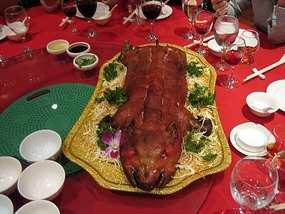
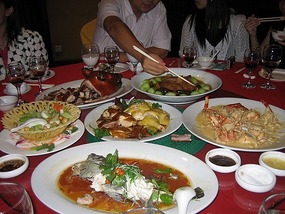
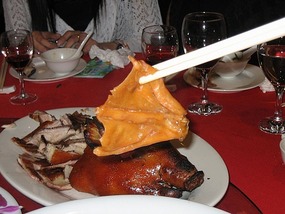
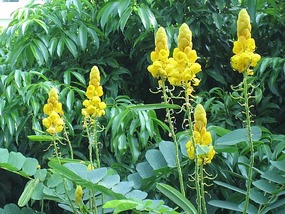
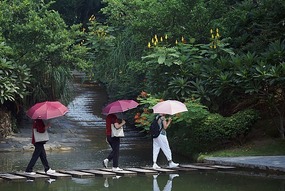
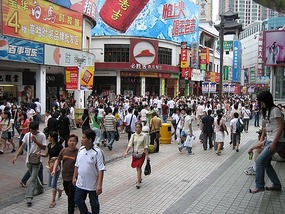
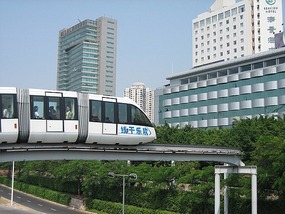
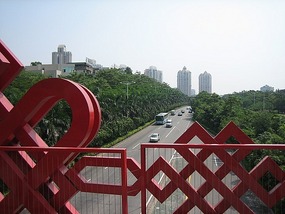
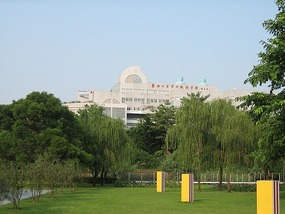
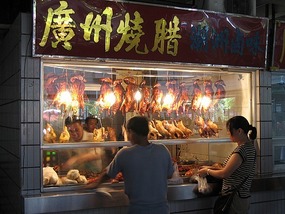


2025-05-22